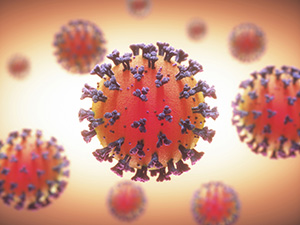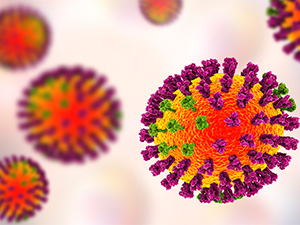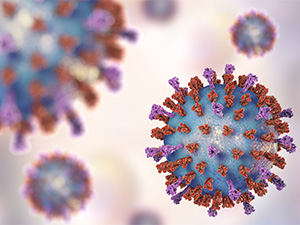By focusing on vulnerable populations, we aim to improve health for everyone across the globe.
At Janssen, we have a deep heritage of caring for those affected by respiratory infections. We have been actively engaged in fighting global pandemics for over a century. In 1918, Johnson & Johnson’s introduced hypodermic needles and sterile gauze masks to help fight the influenza pandemic. This commitment to treating respiratory infections continues today via our current consumer products for everyday respiratory care, as well as our response to the global COVID-19 pandemic.
We are developing a variety of solutions for respiratory infections where innovative treatment and prevention approaches are urgently needed.
 Structure of COVID-19
Structure of COVID-19
Since January 2020, we have been working directly with governments and health authorities to help end the COVID-19 pandemic. We worked with urgency to advance a vaccine for COVID-19 that served populations globally, with special consideration given to some of the most vulnerable communities.
From the beginning, we identified new and impactful ways to optimize clinical trials, reach diverse communities and ensure appropriate representation from all populations in our research. Our COVID-19 vaccine helped protect millions of people, and we continue to focus our efforts on ensuring our vaccine is available for people most in need. Learn More
 Structure of influenza virus
Structure of influenza virus
Influenza evolves and travels quickly, so reducing its burden is a complex challenge. Influenza is one of the top 10 threats to global public health, according to the World Health Organization.1
Nearly one-third of the world’s population became infected during the 1918 Flu Pandemic and at least
50 million people died.2
Today, annual flu epidemics cause three-to-five million cases of severe illness,
resulting in up to 650,000 deaths.4
While seasonal vaccinations are currently the most effective way to prevent infection, reduce transmission, and decrease the severity of illness, during most seasons, influenza vaccines only reduce the risk of requiring visits to healthcare providers by 40 to 60 percent among the overall population.5
An influenza pandemic would pose an extreme public health risk, which is why we are working to combat influenza. This includes a "universal" vaccine with the hope of protecting against a wider variety of influenza strains to potentially reduce the risk of mismatches between vaccine elicited immunity and the circulating vaccine strains.
 Structure of RSV
Structure of RSV
While it is lesser known than flu, RSV is very prevalent, highly contagious, and one of the most common causes of acute respiratory infection.10 With no preventive vaccine or effective antiviral treatment available, RSV is a large health and economic burden globally.6
RSV affects more than 64 million people every year.7
We are exploring alternatives to vaccines such as innovative pre-exposure prophylaxis, or PrEP, approaches for RSV and other respiratory viral infections to prevent the burden of these diseases.
1 World Health Organization. Ten threats to global health in 2019. Available at: https://www.who.int/vietnam/news/feature-stories/detail/ten-threats-to-global-health-in-2019. Last accessed: November 2019.
2 Centers for Disease Control and Prevention. 1918 pandemic (H1N1 virus). Available at: https://www.cdc.gov/flu/pandemic-resources/1918-pandemic-h1n1.html. Last accessed: November 2019.
3 Krammer F, et al. Influenza. Nat Rev Dis Primers. 2018;4(3).
4 World Health Organization. Influenza (seasonal). Available at: https://www.who.int/en/news-room/fact-sheets/detail/influenza-(seasonal). Last accessed: November 2019.
5 Centers for Disease Control and Prevention. What are the benefits of flu vaccination? Available at: https://www.cdc.gov/flu/prevent/vaccine-benefits.htm. Last accessed: April 2023.
6 Falsey AR, Hennessey PA, Formica MA, Cox C, Walsh EE. Respiratory syncytial virus infection in elderly and high-risk adults. N Engl J Med. 2005 Apr 28;352(17):1749–59.
7 National Institute of Allergy and Infectious Diseases. Respiratory syncytial virus (RSV). Available at: https://www.niaid.nih.gov/diseases-conditions/respiratory-syncytial-virus-rsv. Last accessed: November 2019.
8 Oxford Vaccines Group. Respiratory syncytial virus (RSV). Available at: http://vk.ovg.ox.ac.uk/rsv. Last accessed: November 2019.
9 Centers for Disease Control and Prevention. RSV. Available at: https://www.cdc.gov/rsv/research/us-surveillance.html. Last accessed: November 2019.
10 Protect Against Respiratory Syncytial Virus. Available at: https://www.cdc.gov/features/rsv/index.html. Last accessed: April 2024.

